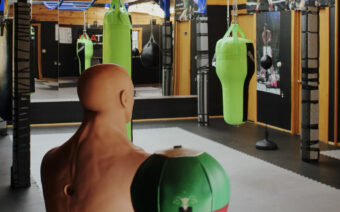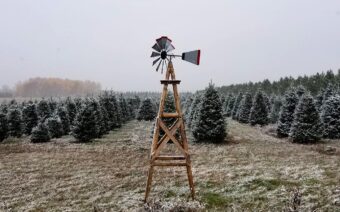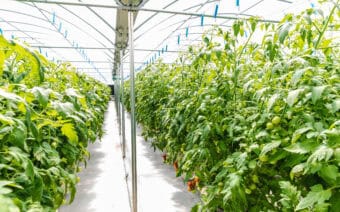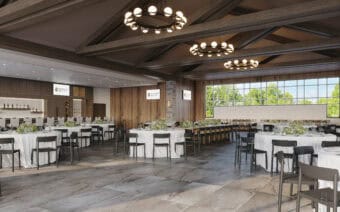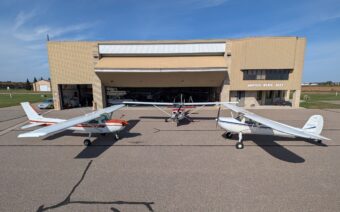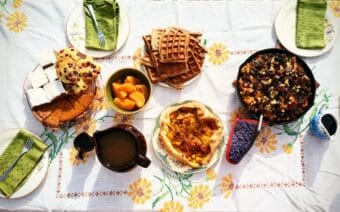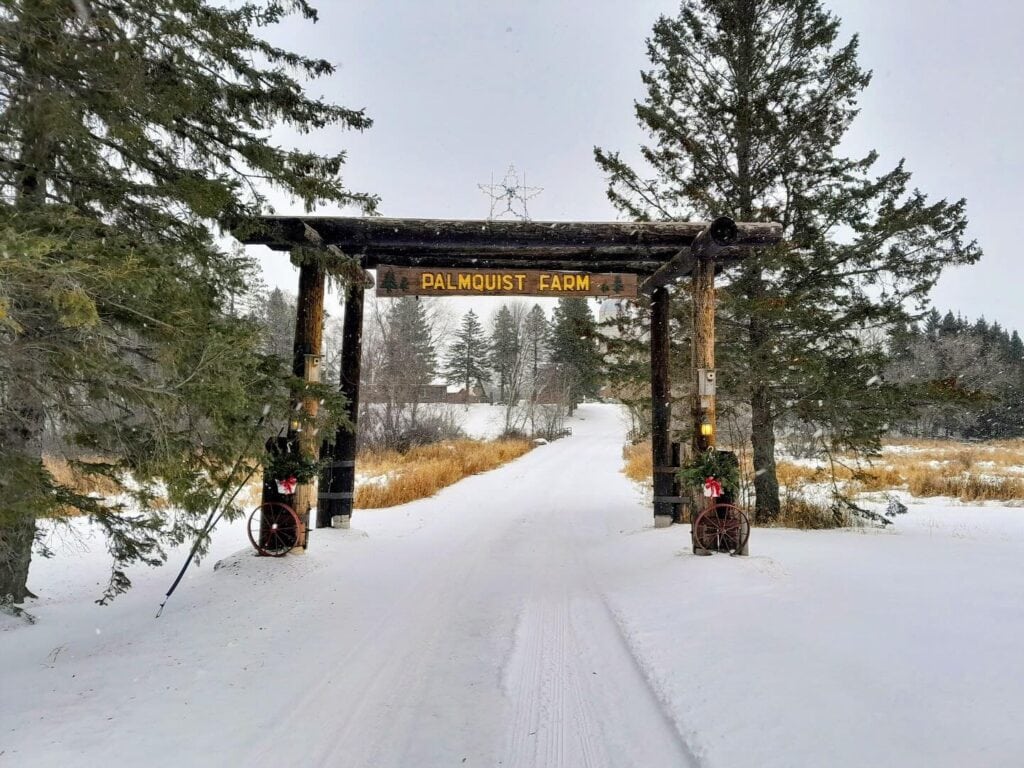
November 10, 2025
BRANTWOOD – The Palmquist family in North Central Wisconsin said it has welcomed guests into their family home since the early to mid-1990s – long before B&Bs or Airbnbs were travel trends.
Anna Palmquist – daughter of farm owners Jim and Helen Palmquist – said Palmquist Farm specializes in what the family calls “great Finnish hospitality.”
Guests of Palmquist Farm have the choice of five lodging options:
- The Maki House, named after family friend and Finnish carpenter John Maki, which sleeps up to 11
- The three-bedroom Red River Cabin, which sits near the Somo River
- The Red House, which is one of the farm’s original cabins
- The White Pine Inn, a tour de force of Finnish log craftsmanship that sleeps 16 people
- The Farmhouse, where meals are served in the main dining room
Finnish hospitality in the Northwoods
As the Palmquist family readies for another winter season – one marked by their Finnish-inspired holiday traditions – Anna said they can’t help but reflect on the enduring traditions that have guided the farm from the start.
“My mom really goes all out with the Christmas decorations,” she said. “We collect bows from our woods, and there’s a group of ladies that come together every year and make wreaths and swags by hand that we decorate the farm with. And we have about five Christmas trees. It feels like walking into a Hallmark Christmas card from the 1950s.”
Located about an hour north and slightly west of Wausau, Anna said Palmquist Farm welcomes guests with the warmth and familiarity of family.
Offering lodging, home-cooked meals, and a variety of activities throughout the year, Anna said the farm is a one-of-a-kind, all-inclusive resort experience.
During the winter months, she said guests can explore the 700-acre property on cross-country ski trails, go sledding, ice skate on the pond, warm up by the lodge’s fire, snowshoe through the woods, enjoy horse-drawn sleigh rides and unwind in a traditional wood-fired sauna.

In the main building’s downstairs dining room, Anna said guests are treated to home-cooked meals and fresh-baked goods.
That commitment to hospitality, Jim said, is one of the aspects of Palmquist Farm that sets it apart from traditional bed-and-breakfasts, offering three meals a day instead of just the “B.”
Roots in Wisconsin tourism history
The farm’s history, Anna said, also offers a fascinating peek into Wisconsin’s tourism origins.
Jim, now 83, said his great-grandparents established the property as a dairy and timber farm in 1906.
Years later, he said his parents began hosting guests to supplement their farm income.
As farms – and much of the world – struggled to recover from the Depression era, Jim said the UW-Extension launched a program encouraging farmers to host vacationers as a way to boost their earnings.
“When [my parents] started, they just rented rooms in our farmhouse,” he said. “It’s quite a large farmhouse. Then they built cabins one and two. When Helen and I took over years later, we built the others.”
Jim said some of the first guests of Palmquist Farm stayed for as long as a month – many of them lawyers, doctors and other professionals who had grown up on farms.
“They would come and help with the farm work, because they kind of missed it,” he said.
During that time, the idea of vacationing, Jim said, was typically reserved for the wealthy.
Just as railroads promoted dude ranches as ideal retreats for urban elites when they pushed westward in the late 1800s, Jim said that same longing for open space later drew families from Milwaukee and Chicago northward in the mid-to-late-1900s, seeking their own slice of the getaway life.
Another factor driving people north, Jim said, was the polio epidemic of the 1940s and ’50s.
“They were so concentrated in the cities, a lot of times the men would send their families to northern Wisconsin to stay at a resort, and then they would come up and visit them periodically,” he said.
When his parents first started welcoming guests, Jim said their goal was to make guests feel at home – even joining them at the family table.
Stories were exchanged about each other’s families and histories, Jim said – a tradition that continues to define the Palmquist Farm experience today.
“I remember my dad and grandparents talking about how people would come and kind of be part of the family,” he said. “They would eat with the family, they would do activities that my family was already planning to do. It wasn’t like how you think of a resort today or how people have to have everything so planned. It was more like, ‘Hey, you’re staying with us and whatever’s happening, you can be a part of.’”
Jim said he loved it when his parents opened up their home – with guests becoming extended family.
That same sense of belonging continues today at Palmquist Farm, Anna said, as they strive to foster a sense of community among guests during their stay – noting that it’s not uncommon for families, couples and other guests who meet at the farm one summer to coordinate their return the following year so they can vacation together again.
“Our dining room is very communal,” she said. “You end up sitting with people that you’re not traveling with, which is a really unique thing that doesn’t happen much anymore. People form connections. Sometimes, I see guests on our Facebook page, commenting on each other’s pictures from their vacations and exchanging contact information.”

Jim said they’ve had people visiting Palmquist Farm for 20 or 30 years.
“The people who want a farm vacation seem to be a special kind of people,” he said. “They’re people who are at peace with themselves and the world. It seems like they look at a vacation differently than people who go to a typical resort.”
A working farm with year-round appeal
Though they welcome guests year-round, Jim said Palmquist Farm remains a working farm, having shifted from dairy cows to beef and feeder cattle several years ago.
When he and Helen took over operations, Jim said they decided to expand the lodging options – even though at the time he was working as a university extension agent, and Helen as a speech therapist in the Tomahawk School District.
“My folks were getting up in years, and we decided that we would just take over the business,” he said.
Eventually, Jim said he and Helen transitioned to running the farm full-time, focusing on attracting the cross-country skiing community – which led to the addition of more cabins and the construction of the White Pine Inn to accommodate the growing number of skiers eager to explore the farm’s roughly 25-kilometer trail system.
Jim said the farm also sees a busy hunting season, with hunters having access to its 700 private acres, as well as 10,000 acres of surrounding public land.
The family, he said, provides guide services, with a special focus on helping families and young people experience their first hunt.
Horses, Jim said, have also long played a central role at the farm – with the trail system being especially popular with horse enthusiasts during the warmer months.
When he was growing up, Jim said his parents kept horses for visitors to ride; however, today guests can bring their own, thanks to a former dairy barn that was converted into a horse barn.
He said Palmquist Farm also serves as a venue for weddings and other events, with groups renting the entire property.
Earlier this year, Jim said a couple, who had vacationed at the farm for several years, tied the knot on site.
The farm’s meeting space, he said, is also a popular choice for area businesses for hosting retreats and planning sessions.
“They’ve said they like to meet here, because there are no distractions,” he said.
Telling the farm’s story
Anna said the farm’s long history inspired the publication of two books: “Farm Food: Palmquist Farm’s Cookbook” and “Palmquist Farm – A Walking Tour.”
The cookbook, she said, grew out of years of guests asking her mom for her recipes and features a special section devoted to her Finnish Christmas dishes.
“My mom was always writing these recipes down for guests, and I thought it was time to put them all together in a book,” she said. “It’s hard to get my mom to sit still. She actually never stops moving. I had to buy her a headset, so she could move around and cook and work while she was telling me the recipes over the phone.”

Anna said capturing her mom’s recipes was a challenge, since she rarely follows recipes or measures ingredients – and seldom makes the same dish the same way twice.
“But, I’m really glad we did it,” she said.
If time allows, Anna said they’d like to release an updated edition with new recipes.
“Palmquist Farm – A Walking Tour,” Anna said, was written by her and her dad and tells the farm’s story via a narrative visit of the property’s landmarks.
Stops along the way, she said, include the farmhouse, all the cabins, a blacksmith shop, a sugar house and an apple tree with a story.
Anna said one of the chapters details how the Maki House cabin was booked before it was built – prompting a construction job completed in record time.
“We had some people who called on Nov. 1 – it was a group of seven or eight people, and they wanted to stay for a week around Christmas,” he said.
After describing this yet-to-be-built cabin to the prospective guest, Jim said they booked it.
“Well, I’ll never do anything like that again,” he laughed. “We worked about 20 hours a day every day for the next seven weeks, and we had it ready Dec. 26. We were sweeping sawdust out the back door when they walked in the front door. I’ll never forget the first thing they said: ‘This cabin seems pretty new.’”
Anna said that right there is why they wanted to write the book – “to keep people connected to the property and its stories.”
Continuing a legacy
Over the decades, Jim said travel writers from the New York Times, Chicago Sun-Times and Reader’s Digest have “fallen in love with the place.”
Though many of the vacation farms of years past have come and gone, Anna said Palmquist is “one of the last ones standing.”
“I think what my parents have built and who they are is a really special thing,” she said. “And it is a dying thing. I hope we can continue this tradition for many more families. The most important part of what we do – that I want to carry forward – is the way we create community and connection. No matter who you are, no matter what you think or believe, if you’re at the farm, you’re family.”
 Pondview Lavender Farm: A budding business
Pondview Lavender Farm: A budding business The Barn at Mirror Lake provides a one-stop shop for weddings
The Barn at Mirror Lake provides a one-stop shop for weddings

